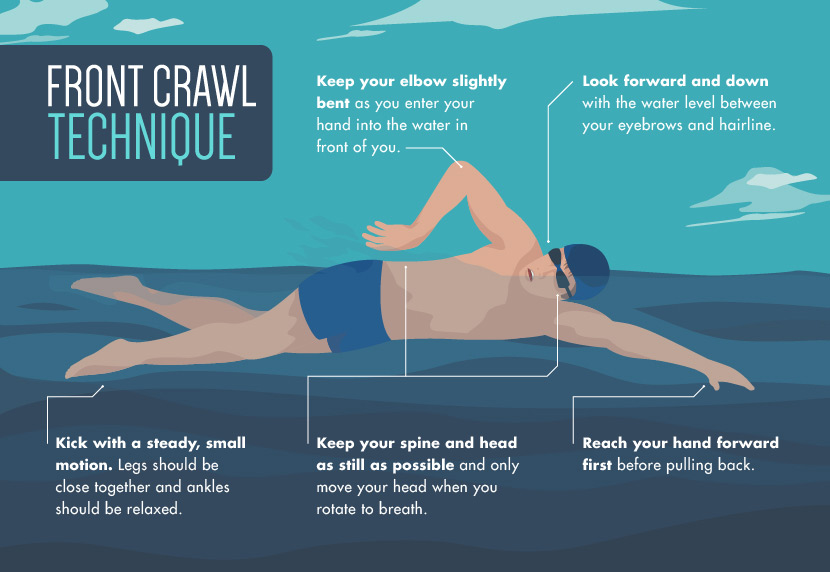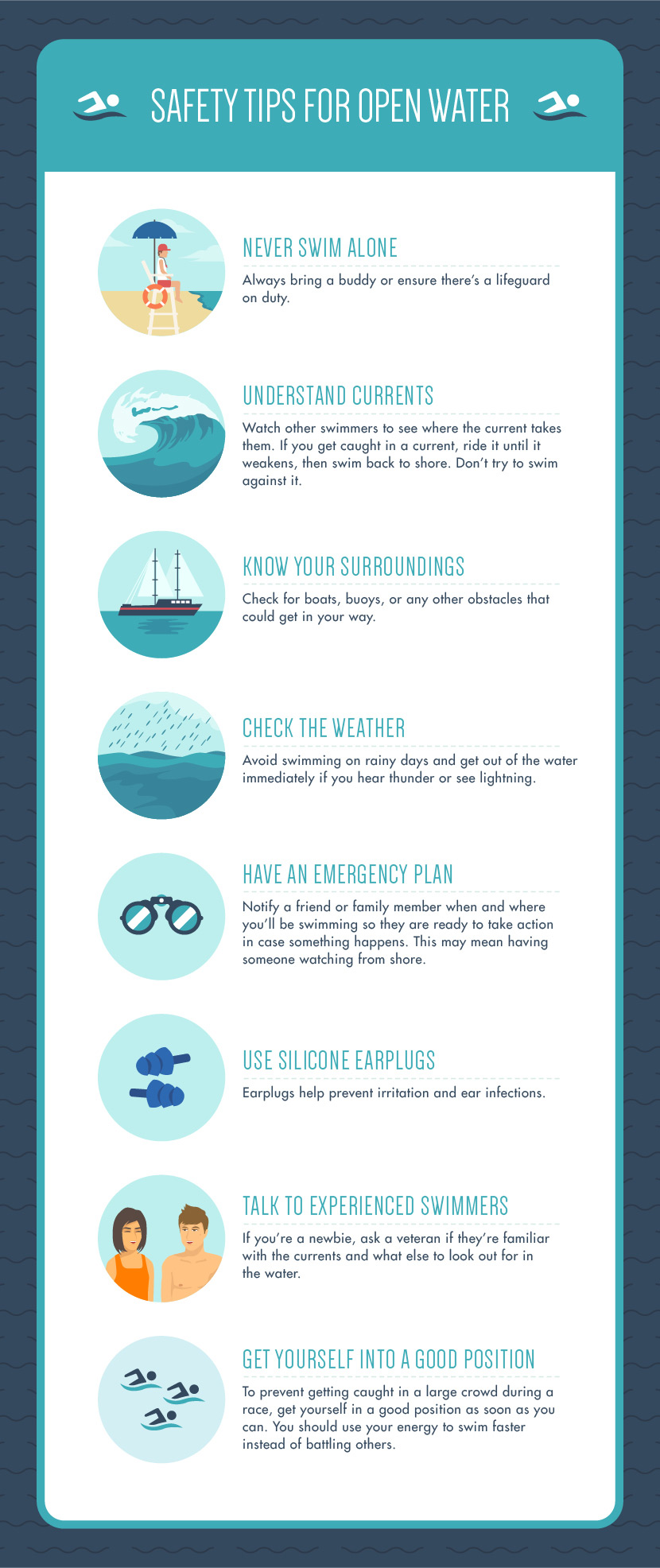
Get your fix of expert articles delivered straight to your inbox!
No Thanks - I don't like cool stuff

Swimming in a pool is one of the best workouts: it tones the entire body and doesn’t require any fancy equipment. But if you’re tired of staring at the same black line on the bottom of the pool, open-water swimming offers new challenges and scenery.http://www.shape.com/blogs/working-it-out/8-reasons-start-swimming Boredom isn’t the only reason to make the switch; taking the plunge into the cold water may boost your immune system and blood circulation.http://www.simplyswim.com/blog/the-health-benefits-of-outdoor-swimming/ Your body reacts to the cold by producing more white blood cells, which help fight infections, and increasing blood flow to your organs.http://www.healthline.com/health/wbc-count#Overview1
But taking a swim outdoors – either recreationally or for a big event – isn’t as simple as you may think. Some smart training indoors can prepare you for the temperature difference and minimal visibility that often comes with ocean or lake swimming. To take advantage of the freedom of open-water swimming (i.e., not having to share a lane), read on for tips to stay safe, get some exercise, and, most importantly, have fun.
It’s easy to swim straight with lane lines and the bottom of the pool to keep you in check. But it’s hard to stay straight in open water when you can’t see the bottom and the current pulls you away from shore. To train yourself in the pool, close your eyes for eight to 10 strokes, then pull your head up above the water to check your direction.http://www.active.com/swimming/articles/6-tips-to-help-transition-from-the-pool-to-open-water-883425 Most people naturally swerve left or right. Once you figure out which direction you tend to swerve, tweak your stroke to straighten your line.
Think quality over quantity when it comes to strokes. Longer, more powerful strokes will get you farther than quick strokes. (They also won’t tire you out as fast.) In the pool, start counting how many strokes you typically take in one length and aim to maintain that number of strokes during a longer set. For more experienced swimmers, work on getting that stroke count down while maintaining the same speed. Try using a swimmer’s snorkel; you won’t have to worry about breathing and can focus on your stroke and body rotation instead.http://www.active.com/swimming/articles/10-swimming-tips-for-beginners

If you tend to breathe on one side in the pool, it’s time to practice alternating sides. It’s necessary in open water events to see the landmarks and other swimmers on both sides of you – unless someone is right next to you, at which point you may want to breathe the opposite way to avoid splashing or getting hit in the face.http://www.swimming.org/swimfit/preparing-in-the-pool/ Practice alternating sides in the pool by letting your head join the rotation of your shoulders. Focus on your technique so it becomes more comfortable and in tune with your rhythm.
During an open water event or triathlon, there’s no wall to hold on to or kick off of when it’s time to start. Instead, you’ll need to learn how to do shallow dives to get past waves and transition smoothly into the race. In the shallow end of a pool, practice dolphin diving by pushing forward from a standing position off the bottom.
During open-sea events, you’ll need to run in until knee-high, and then dolphin dive under the water breaks. Keep your head down and tucked between your arms. Looking up will slow you down. At the end of an open-water event, use the waves as momentum to push you forward to shore. When you turn your head to breathe, look back slightly to see what’s coming. If a wave is about to crash on you, dolphin dive and bodysurf to shore until your belly hits the sand.

Our bodies lose heat in cold water about 70 times faster than in cold air, and respond to cold by constricting blood vessels and increasing metabolism for energy, which can hurt race performance. To adjust your body to the cold temperature, swim in open water for 20 to 30 minutes, three to four times a week, for about three weeks before an event. Your body is able to acclimatize to the cold temperature so it uses less energy to keep warm. If you don’t have access to cold water, take a cold bath with ice three times a week for about three weeks prior to an event.
Be cautious when swimming or bathing in cold water; get out immediately if you feel uncomfortable or your skin starts turning blue. Start slow and build tolerance over time.http://www.active.com/swimming/articles/acclimating-your-body-to-cold-water-882380?page=2
When you arrive for your first event, enter the water about a minute before the start. It’s important to calmly enter before racing to allow your body to acclimatize to the temperature and stabilize your breathing. Try not to get in with too much time before the start or you may begin to shiver.http://www.active.com/swimming/articles/how-to-warm-up-right-for-an-open-water-race-882852
Most open-water events are long, with no opportunities to stop. In this case, it’s important to feel comfortable in your gear and confident it will last until the finish line. If the event allows a wet suit, wear it for a couple practices so your body can adjust to the way it feels.http://www.active.com/swimming/articles/6-tips-to-help-transition-from-the-pool-to-open-water-883425 If you notice any places that chafe during a long event – such as under swimsuit straps – apply Vaseline to that area before the race.http://www.active.com/swimming/articles/10-open-water-tips-from-a-woman-s-point-of-view-874622
Try to use your goggles in the open water before a race to make sure they’re well suited for the environment. If it’s a cloudy or rainy day, opt for clear goggles, but if it’s a bright and sunny day, use dark-tinted goggles to block out the sun’s rays.http://www.active.com/swimming/articles/10-swimming-tips-for-beginners?page=2 Wear your goggles under your cap to prevent them from slipping off your head or getting knocked off if the event is crowded.http://www.active.com/swimming/articles/10-open-water-tips-from-a-woman-s-point-of-view-874622

Whether you’re training for a big race or going for a casual outdoor swim, the most important part is to stay safe and have fun. Always warm up before diving in, to increase blood circulation to your muscles. If you cannot do a warm-up in the water before a race, do a light jog and perform some shoulder rotations to loosen muscles.http://www.ironman.com/triathlon/news/articles/2013/09/5-swimming-mistakes-to-avoid.aspx#axzz3z7rnwZms Once you’re in the water, embrace nature and the fresh air.
Written by:

Get your fix of expert articles delivered straight to your inbox!
No Thanks - I don't like cool stuff